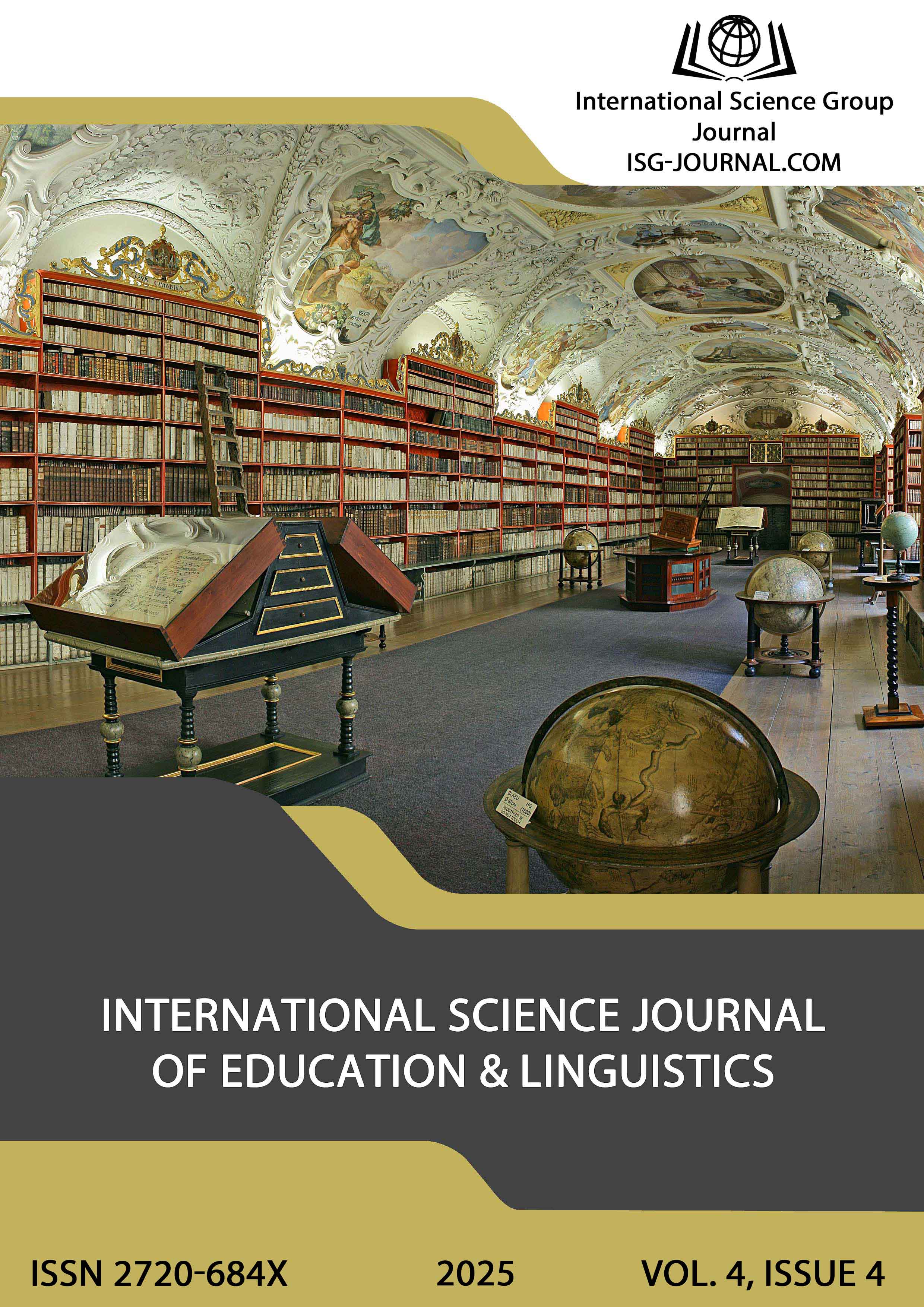Word-formation and derivational paradigms as a methodological basis for the nostrification of units of the language system
DOI:
https://doi.org/10.46299/j.isjel.20250404.02Keywords:
word formation, derivation, word-formation type, morphematic type, derivational paradigm, word-formation and derivational models, word-formation and derivational formants, active/passive word-formation formant, word-formation pair, derivational pair, syntagmatic (paradigmatic) aspect of the studyAbstract
our article concerns the issue of revealing the methodological foundations of the nostrification of units of the lexical level of a language, French in particular, in the context of considering word-formation and derivational systems. Attention is focused on studying the features of the functioning of units of the morpheme level as components of the word-formation type and derivational paradigm, which is due to the syntagmatic and paradigmatic aspects of considering the features of the functional capacity of morpheme units of the adjective category of the French language in the context of the graphic form of a lexical-semantic unit, determined by the grammatical category of the French adjective. Attention is paid to the correlation of semantic and grammatical meanings of a lexeme in the issue of determining the mechanism of formation of lexical units in the systems of word-formation and derivation of a particular language, which determines the factors of formation not only of lexical new formations, but also of word combinations as units of a higher level of the language. The syntagmatic and paradigmatic aspects of the manifestation of word-forming processes and the features of the creation of a derivational paradigm at the lexical level are taken into account. The concepts of word-formation and morphematic types are distinguished, taking into account the methodological concept of studying morpheme activity in the context of word-formation and derivation processes, determined by a delimited perception of word formation and derivation with the prospect of studying the function of morphemes in the conditions of their actualization by word-formation and morphematic types. The syntagmatic aspect of the study of word-formation processes is defined as one that contributes to the disclosure of the features of the formation of word-formation models, while the paradigmatic aspect of the study of derivational processes organizes the paradigmatic relations of morpheme components of the paradigmatic derivational model of the lexical level. The sign of the activity of different-level language units is distinguished, which is based on the characteristics of the word-formation activity of morphemes and the characteristics of the quantitative component of the morpheme structure of the lexeme. The word-formation activity of a morpheme reveals the regularities of the formation of a word-formation type, the quantitative component of the morpheme structure determines the conditions for the formation of a derivational paradigm. A methodological justification for the definition of word formation and derivation as separate sections of lexicological science is formulated and the basic categories of their actualization are identified.References
Безпояско О. К. І корінь, і суфікс. Культура слова. Київ : Наук.думка. Вип. 36. 1989. С. 77–79.
Берест Т. М., Шумейко О. А. Репрезентація концепту «успіх» в українській фразеології. Наукові записки Національного університету «Острозька академія»: серія «Філологія». Острог : Видво НаУОА. Вип. 22(90), 2024. С. 8–11. doi: 10.25264/25192558202422(90)811
Бойко В. М., Давиденко Л. Б. (2014). Граматика української мови: Морфеміка. Словотвір. Морфологія : навч. посіб. Київ : Академвидав, 248 с.
Вакарюк Л. О., Панцьо С. Є. (2004). Українська мова. Морфеміка і словотвір. Тернопіль: Навчальна книга – Богдан, С. 18-41.
Горпинич В. О. (1999). Сучасна українська літературна мова. Морфеміка. Словотвір. Морфонологія. Київ : Вища школа, 206 с.
Ґрещук , В., & Ґрещук , В. (2023). Дериватологійна концепція професора П. І. Білоусенка. Лінгвістичні студії, С. 7-16. https://doi.org/10.31558/1815-3070.2023.46.1)
Іщенко Валентина, Горбуньова Соф’я, Стеценко Володимир. (2023). Структурно-семантичні характеристики термінологічної лексики в художньому творі та особливості її перекладу (на матеріалі роману Джона Грішема «Фірма»). Лінгвістика. Збірник наукових праць 1(47). Полтава, С. 121-132. doi: 10.12958/2227-2631-2023-1-47-121-132
Клименко Н. Ф. (1998). Основи морфеміки сучасної української мови. Київ : ІЗМН, С. 10-44.
Клименко Н. Ф., Карпіловська Є. А. (1998). Словотвірна морфеміка сучасної української літературної мови. Київ, 1998. С. 13–42.
Клименко Н. Ф., Карпіловська Є. А., Карпіловський В. С., Недозим Т. І. (1998). Словник афіксальних морфем української мови. Київ: Інститут мовознавства ім.О.О. Потебні, 441 с.
Клименко Н.Ф., Є. А. Карпіловська Є.А., Кислюк Л.П., Романюк Ю.В. (2019). Українська мова в контексті сучасної славістики. Київ., 660 с. Режим доступу: Національна академія наук України
Мішеніна Т.М. Структурно-семантичні особливості фауно- і флоронімів у сучасній українській мові. Структура і семантика мовних одиниць. Електронний ресурс: 45-55 (4).
Полюга Л. М. (2009). Словник українських морфем. Вид. 3-є, доповн. і випр. Київ: Довіра 554 с.
Тарасюк Н.Ю. (2016). Словотвірна модель бачення світу як чинник мотивації словотвірного значення. Славістичні студії. Етнолінгвістика і міжкультурна комунікація, 3, С.287-294. Режим доступу: Тарасюк Н._Словотвірна модель бачення світу.
Ferdinand de Saussure. (Ed.) (1995). Cours de linguistique générale. Paris : Editions Payot et Rivages, 269 с. Режим доступу: Saussure
Havryshchak, O., Protsiv Ya. Лінгвофілософська система Вільгельма фон Гумбольдта: історико-біографічний аспект. Режим доступу: https://ojs.tdmu.edu.ua/index.php/med_osvita/article/view/10871/10386
Pinker, Steven (1999). Words and Rules: The Ingredients Of Language (Science Masters Series). С. 1-2. Режим доступу: https
Le Petit Robert de la langue française. 2024. version 10.0. Режим доступу: www
Downloads
Published
How to Cite
Issue
Section
License
Copyright (c) 2025 Nataliya Tarasyuk

This work is licensed under a Creative Commons Attribution 4.0 International License.





